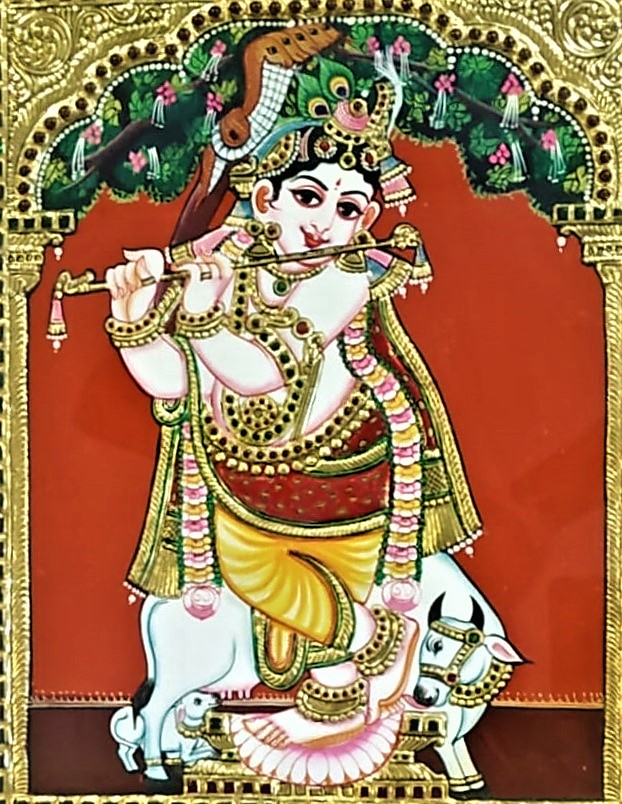
Tanjore Paintings - Shree Krishna
Shree Krishna - Tanjore / Thanjavur Paintings
Krishna (/ˈkrɪʃnə/, Sanskrit pronunciation: [ˈkr̩ʂɳɐ]; Sanskrit: कृष्ण, IAST: Kṛṣṇa) is a major deity in Hinduism. He is worshipped as the eighth avatar of the god Vishnu and also as the supreme God in his own right. He is the god of compassion, tenderness, love and is one of the most popular and widely revered among Indian divinities. Krishna's birthday is celebrated every year by Hindus on Krishna Janmashtami according to the lunisolar Hindu calendar, which falls in late August or early September of the Gregorian calendar. Krishna is usually depicted with a flute in his hand.
The anecdotes and narratives of Krishna's life are generally titled as Krishna Leela. He is a central character in the Mahabharata, the Bhagavata Purana and the Bhagavad Gita, and is mentioned in many Hindu philosophical, theological, and mythological texts. They portray him in various perspectives: a god-child, a prankster, a model lover, a divine hero, and as the universal supreme being. His iconography reflects these legends, and shows him in different stages of his life, such as an infant eating butter, a young boy playing a flute, a young boy with Radha or surrounded by women devotees, or a friendly charioteer giving counsel to Arjuna.
The synonyms of Krishna have been traced to 1st millennium BCE literature. In some sub-traditions, Krishna is worshipped as Svayam Bhagavan, and this is sometimes referred to as Krishnaism. These sub-traditions arose in the context of the medieval era Bhakti movement. Krishna-related literature has inspired numerous performance arts such as Bharatanatyam, Kathakali, Kuchipudi, Odissi, and Manipuri dance. He is a pan-Hindu god, but is particularly revered in some locations such as Vrindavan in Uttar Pradesh, Dwarka and Junagadh in Gujarat; the Jagannatha aspect in Odisha, Mayapur in West Bengal ; in the form of Vithoba in Pandharpur, Maharashtra, Nathdwara in Rajasthan; Udupi Krishna in Karnataka, Parthasarathy in Tamil Nadu and Guruvayoorappan in Guruvayoor in Kerala. Since the 1960s, the worship of Krishna has also spread to the Western world and to Africa, largely due to the work of the International Society for Krishna Consciousness (ISKCON).
The tradition of Krishna appears to be an amalgamation of several independent deities of ancient India, the earliest to be attested being Vāsudeva. Vāsudeva was a hero-god of the tribe of the Vrishnis, belonging to the Vrishni heroes, whose worship is attested from the 5th-6th century BCE in the writings of Pāṇini, and from the 2nd century BCE in epigraphy with the Heliodorus pillar. At one point in time, it is thought that the tribe of the Vrishnis fused with the tribe of the Yadavas, whose own hero-god was named Krishna. Vāsudeva and Krishna fused to become a single deity, which appears in the Mahabharata, and they start to be identified with Vishnu in the Mahabharata and the Bhagavad Gita. Around the 4th century CE, another tradition, the cult of Gopala-Krishna, the protector of cattle, was also absorbed into the Krishna tradition.
Krishna is represented in the Indian traditions in many ways, but with some common features. His iconography typically depicts him with black, dark, or blue skin, like Vishnu. However, ancient and medieval reliefs and stone-based arts depict him in the natural color of the material out of which he is formed, both in India and in southeast Asia. In some texts, his skin is poetically described as the color of Jambul (Jamun, a purple-colored fruit).
Krishna is often depicted wearing a peacock-feather wreath or crown, and playing the bansuri (Indian flute). In this form, he is usually shown standing with one leg bent in front of the other in the Tribhanga posture. He is sometimes accompanied by cows or a calf, which symbolise the divine herdsman Govinda. Alternatively, he is shown as a romantic young boy with the gopis (milkmaids), often making music or playing pranks.
Krishna lifting Govardhana at Bharat Kala Bhavan, recovered from a Muslim graveyard in Varanasi. It is dated to the Gupta Empire era (4th/6th-century CE).
In other icons, he is a part of battlefield scenes of the epic Mahabharata. He is shown as a charioteer, notably when he is addressing the Pandava prince Arjuna character, symbolically reflecting the events that led to the Bhagavad Gita – a scripture of Hinduism. In these popular depictions, Krishna appears in the front as the charioteer, either as a counsel listening to Arjuna, or as the driver of the chariot while Arjuna aims his arrows in the battlefield of Kurukshetra.
Alternate icons of Krishna show him as a baby (Bala Krishna, the child Krishna), a toddler crawling on his hands and knees, a dancing child, or an innocent-looking child playfully stealing or consuming butter (Makkan Chor), holding Laddu in his hand (Laddu Gopal) or as a cosmic infant sucking his toe while floating on a banyan leaf during the Pralaya (the cosmic dissolution) observed by sage Markandeya. Regional variations in the iconography of Krishna are seen in his different forms, such as Jaganatha in Odisha, Vithoba in Maharashtra, Shrinathji in Rajasthan and Guruvayoorappan in Kerala.
Guidelines for the preparation of Krishna icons in design and architecture are described in medieval-era Sanskrit texts on Hindu temple arts such as Vaikhanasa agama, Vishnu dharmottara, Brihat samhita, and Agni Purana. Similarly, early medieval-era Tamil texts also contain guidelines for sculpting Krishna and Rukmini. Several statues made according to these guidelines are in the collections of the Government Museum, Chennai.